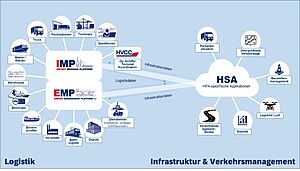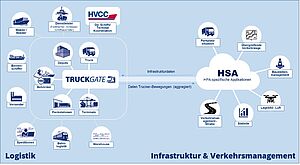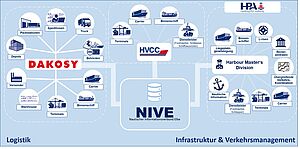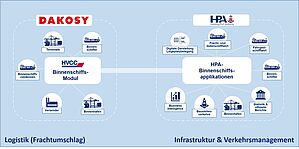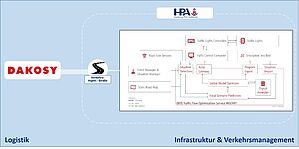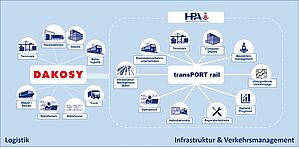Article • 16.06.2022
Funding project SANTANA
Logistics and infrastructure data cleverly combined
Not everything needs to be reinvented from scratch. Based on this principle, a "network of networks" is currently being created in the Port of Hamburg. Existing logistics IT platforms are being connected more effectively with systems for infrastructure and traffic management. All port users are sure to benefit.
The funding project SANTANA
is the acronym for SERVICE AND DATA NETWORK PORT OF HAMBURG and aims to build a network of networks as an ecosystem for data sharing and data services in the Port of Hamburg.
Project objective: Increased efficiency through better networking between logistics and port infrastructures
Project duration: 01.01.2022 - 30.06.2024
Project budget: Total volume: approx. 15 million € (HPA: approx. 13 million € / DAKOSY approx. 1.7 million €)
The timetable is a challenging one: a digital testing ground for the Port of Hamburg is to be established within 30 months, after which it will be opened up to all port operators. During this period, a common marketplace for digital service offerings will be created that is accessible to all involved in the port and hinterland. Project partners Hamburg Port Authority (HPA) and DAKOSY are working at full speed on this ambitious goal. The framework is based on the SANTANA project (Services and Data Network Port of Hamburg), which is being funded with nearly 15 million euros from the German Federal Ministry for Digital and Transport (BMDV).
"The intended results should be immediately apparent and quantifiable to the port's stakeholders," explains Evelyn Eggers, authorized officer and project manager of Santana at DAKOSY, citing several examples: "These include optimized traffic light coordination, an overview of truck parking capacities in the port, and better route planning through a comprehensive traffic guidance system."

"The intended results should be immediately apparent and quantifiable to the port's stakeholders. These include optimized traffic light coordination, an overview of truck parking capacities in the port, and better route planning through a comprehensive traffic guidance system."
Six key measures:
In total, DAKOSY and the HPA want to implement six specific measures to optimize the traffic flow on waterways, roads and rail. Also on board as associated partners are the terminal operators HHLA and EUROGATE as well as the Hamburg Vessel Coordination Center (HVCC), which is responsible for ship coordination. "Their participation is of vital importance for the success of the project, since as process participants they use the services and the data," clarifies HPA project manager Dr. Phanthian Zuesongdham.
In light of the ambitious schedule, Eggers and Zuesongdham plan to test the measures under real conditions in so-called "living labs." "The advantage is that we can directly demonstrate the feasibility of the measures for practical applications, while at the same time operating in a sheltered test environment," says Eggers.
Access to information from the infrastructure sector about construction sites, traffic information in the port, current parking situation
Provision of planning data and real-time information on truck movements, i.e., about the use of particular sectors of the infrastructure for active traffic management
Optimization of tour planning for trucking companies and status updates

Added value through data sharing
The project is built around existing IT structures and data. Now it is a matter of linking these via hubs and interfaces and thus generating new added value. Both DAKOSY and the HPA will contribute data to the common system. One example is the planned measure "Container Logistics on the Road," which demonstrates how this works. "The HPA will provide information from the infrastructure sector regarding construction sites, traffic information in the port and the parking situation," Zuesongdham enumerates. DAKOSY will contribute planning data and up-to-the-minute information on truck movements. "We already have the status reports from slot booking management and other sources. It goes without saying that these are aggregated and anonymized. Broken down to particular route sections, they then provide a reliable picture of the expected road usage at various times," explains Eggers.

"The HPA will provide information from the infrastructure sector regarding construction sites, traffic information in the port and the parking situation."
Optimized parking space search for trucks planned
Additional services can be generated by matching infrastructure and logistics information. One is the optimized search for parking spaces. "If you create transparency about available parking spaces, the traffic situation and waiting times at the terminals, drivers will be able to reserve the most suitable parking space for themselves in the future, taking into account driving and break times," according to Eggers' and Zuesongdham's vision. Traffic reduction, lower CO2 emissions and decreased road wear are further advantages, they say, if a driver heads directly to a specific parking space and does not - as is often the case today - cover three to four times the distance while searching.
Port-wide traffic light coordination
The project partners have planned targeted data sharing not only in the road sector, but for all modes of transport in the Port of Hamburg. In addition, particular attention is being paid to import and export processing as well as traffic flow optimization on the road network in the port. For the latter measure, quantum-inspired technology for real-time management of the traffic light network is being constructed. "With the method of so-called quantum annealing, we will be able to calculate a port-wide coordinated traffic light management system in a matter of seconds," says Zuesongdham, citing one of the targeted milestones.
Project partners
Collaboration partners:
- HPA Hamburg Port Authority
- DAKOSY Datenkommunikationssystem AG
Associated partners:
- EUROGATE GmbH & Co. KGaA, KG
- HHLA Hamburger Hafen und Logistik AG
- HVCC Hamburg Vessel Coordination Center GmbH
Supporting partner:
Freie und Hansestadt Hamburg, Behörde für Wirtschaft und Innovation
One marketplace for all services
All the new digital service offerings are to be made available to the participants in the port and hinterland via a common marketplace. A time- and resource-consuming search for information, which today can take many hours, will then become a thing of the past.
The idea of a digital marketplace has been on the minds of Zuesongdham and Eggers for many years. On behalf of HPA and DAKOSY, they have both been long involved in the EU's Digital Transport & Logistics Forum (DTLF), with the aim of creating a collaborative structure for networking various digital platforms for the exchange of logistics data between operators in different member states. This concept is known as the Federated Network of Platforms. With SANTANA, Zuesongdham and Eggers now want to demonstrate on a local level that this concept can be made operational in a complex ecosystem for the first time. "The knowledge we gather will flow back toward the EU," the project partners affirm.
